
|
|
|
|
 |
|
Home Site Search Contact Us Subscribe
|
|
|
|
Straight A's: Horace Mann Elementary School by Moore Ruble Yudell
San Jose, California: A student "village" makes a good neighbor in the heart of an urban historic district. by ArchNewsNow April 13, 2004 San Jose, California, is a city that takes pride in
its many downtown open spaces and planned linear connections. Located on three
acres at the eastern edge of historic downtown, the new $21.5 million Horace
Mann Elementary School, designed by Santa Monica-based Moore Ruble Yudell, is a
cohesive campus of forms and courtyards that respond to the urban context. The
new buildings step from one to three stories, and a variety of courtyards, turf
play areas, terraces, and gathering spaces provide a link between the school
and the larger community. "Children deserve a
comfortable place," says Moore Ruble Yudell Senior Associate James Mary
O'Connor. “We wanted to create the opportunity for wonder and exploration.” In addition to classrooms
for 750 students from kindergarten to 5th grade, the new campus
includes an administration wing, a library with an expanded media center,
unassigned or “lab” classrooms for special uses (such as a computer lab,
cooking demonstrations, etc.), a child care facility (phase 2), and a large
multipurpose cafetorium – a flexible
lunchroom that doubles as an auditorium for school assemblies, as well as
lectures, plays, and other community gatherings. The project is part of a
larger urban design master plan that also includes the new San Jose City Hall
and Civic Center complex nearby. The design emphasizes
clarity in plan, as well as continuity and contiguity of the different
components. An academic building stretching along Sixth Street and the north
boundary of the site houses classrooms, kindergarten, and a library on the
second floor facing East Santa Clara Street. The administration building is
centrally located and faces the main entry with views of the entire campus. The
multipurpose cafeteria building anchors the corner of Seventh and Santa Clara,
with easy access to play fields as well as to the public when the space is used
for off-hour community programs. Building systems are laid
out for flexibility to allow for area zoning to accommodate a variety daytime
and seasonal use for different programs. A campanile-like stair tower features
balconies as social spaces, and sculptural exterior stairways link rooftop play
areas and circulation galleries to the ground. Translucent canopies cover
walkways and offer a protected outdoor spot for lunching outside the
cafetorium. Interior spaces take
advantage of natural light and ventilation for a high-quality learning and work
environment. The material palette relates the school to its surroundings, yet
also distinguishes it from its neighbors. Masonry block units, integrally
colored in ochre tones, create a tough but finely textured base to the
buildings relating to surrounding structures (the historic Vintage building,
the Kasota stone of the San Jose Museum, and the bluff travertine planned for
the Civic Center), and is at the same time appropriate to an elementary school.
Metal cladding on the upper floors and on gently pitched roof forms provide a
durable and memorable image against the sky. Project
credits: Owner: San
Jose Unified School District; The Redevelopment Agency of the City of San Jose Design
Architect: Moore Ruble Yudell Design
Team: John Ruble, FAIA (Principal-in-Charge), Buzz Yudell, FAIA (Principal),
James Mary O'Connor (Senior Associate-in-Charge), Adam Padua (Project Manager),
Tina Beebe, Kaoru Orime, Yana Khudyakova (Colors and Materials), Alberto
Reano, Lisa Belian, Ed Diamante, Martin Saavedra, Roger Lopez, Tony Tran,
(Project Team), Mark Grand, Matthew Vincent, Vely Zajec, Lance Collins (Models) Executive
Architect: BFGC Architects Planners Inc., David R. Cartnal, FAIA (Principal
Architect), Rob Hikido (Project Manager) Landscape
Architect: Pamela Burton & Co., Pamela Burton (Principal), Angie Coyier
(Project Manager) Rendering:
Al Forster Photography:
John Edward Linden; Art Gray (310-450-2806); Steve Proehl/Aerial
Photographer (707-824-9943) Manufacturer's/Suppliers: Aluminum
Windows: Moduline Windows, Inc. Since the
founding of Moore Ruble Yudell Architects &
Planners with
Charles Moore in 1977, principals John Ruble and Buzz Yudell have built a
varied body of work ranging from private residences to multi-million-dollar
institutional, civic, and mixed-use developments. The initial goal of Moore
Ruble Yudell was to have an intensive collaboration among the principals, with
the collaborative spirit extending to include project staff and clients. The
principals pioneered the use of client and community workshops in the design
process. Their work on a wide range of building types has given them extensive
experience working with complex client groups as well as regulatory and
governmental agencies. The firm has received numerous major awards for design
excellence. Also featured on
ArchNewsNow: Malmö, Sweden: Technology and
environmental sustainability, along with natural light, playful colors and
textures, and a garden, offer a civilized setting for urban dwellers. |
(click on pictures to enlarge) 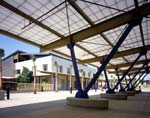 (John Edward Linden) Horace Mann Elementary School: administration building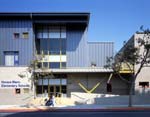 (John Edward Linden) Sixth Street entry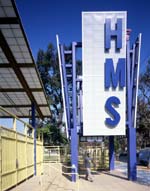 (John Edward Linden) The translucent entry marquee is crafted from steel and Kalwall.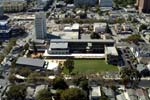 (Steve Proehl Aerial Photographer) Aerial view of campus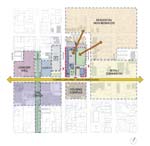 (Moore Ruble Yudell) Site plan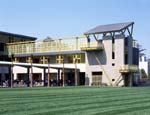 (John Edward Linden) Third-floor upper playground and lower playing field give two options for recreation areas.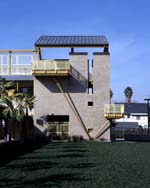 (Art Gray) The stair tower, with balconies as social spaces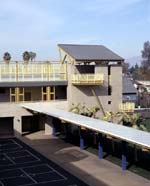 (Art Gray) Stair tower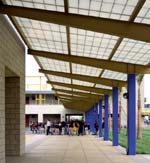 (John Edward Linden) The translucent Kalwall canopy resembles a shoji screen.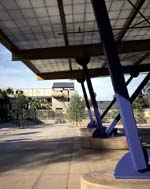 (Art Gray) The canopy outside the cafetorium offers al fresco lunching.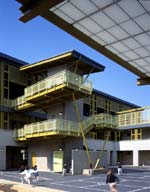 (John Edward Linden) The central stairway is inspired by a child's tree house.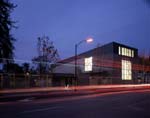 (Art Gray) Exterior view of multi-functional cafetorium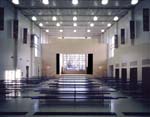 (Art Gray) Cafetorium interior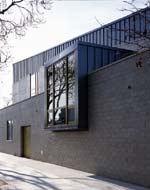 (Art Gray) Cafetorium street-front window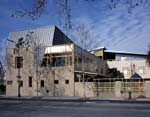 (Art Gray) Library exterior, along Santa Clara Street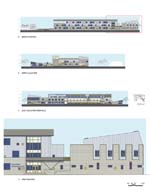 (Moore Ruble Yudell) Elevations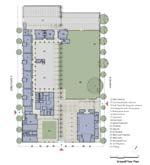 (Moore Ruble Yudell) Ground floor plan (Moore Ruble Yudell) Site plan showing paving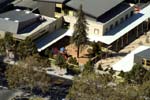 (Steve Proehl Aerial Photographer) Kindergarten playground with administration building to the right |
© 2004 ArchNewsNow.com